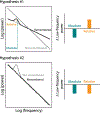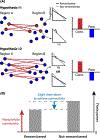Theta Oscillations in Human Memory
- PMID: 32029359
- PMCID: PMC8310425
- DOI: 10.1016/j.tics.2019.12.006
Theta Oscillations in Human Memory
Abstract
Theta frequency (4-8 Hz) fluctuations of the local field potential have long been implicated in learning and memory. Human studies of episodic memory, however, have provided mixed evidence for theta's role in successful learning and remembering. Re-evaluating these conflicting findings leads us to conclude that: (i) successful memory is associated both with increased narrow-band theta oscillations and a broad-band tilt of the power spectrum; (ii) theta oscillations specifically support associative memory, whereas the spectral tilt reflects a general index of activation; and (iii) different cognitive contrasts (generalized versus specific to memory), recording techniques (invasive versus noninvasive), and referencing schemes (local versus global) alter the balance between the two phenomena to make one or the other more easily detectable.
Keywords: SME; associative memory; intracranial EEG; spectral tilt; theta.
Copyright © 2019 Elsevier Ltd. All rights reserved.
Figures





References
-
- Mayes A et al. (2007) Associative memory and the medial temporal lobes. Trends Cogn. Sci 11, 126–135 - PubMed
-
- Moser EI et al. (2008) Place Cells, Grid Cells, and the Brain’s Spatial Representation System. Annual Review of Neuroscience 31, 69–89 - PubMed
-
- O’Keefe J and Recce ML (1993) Phase relationship between hippocampal place units and the EEG theta rhythm. Hippocampus 3, 317–330 - PubMed
-
- Buzsáki G (2005) Theta rhythm of navigation: link between path integration and landmark navigation, episodic and semantic memory. Hippocampus 15, 827–840 - PubMed
Publication types
MeSH terms
Grants and funding
LinkOut - more resources
Full Text Sources

